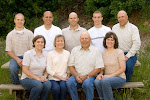For a Saturday activity on September 21, a group of senior missionaries visited the Palace of the Romanov Boyars. It was built in the 16th century and was the home of the Romanovs before they became Russia's ruling family and moved to the Kremlin. It has been a museum since the 19th century when it was restored. We had been wanting to visit this museum, but during the winter they were doing more restorations and it was closed .
David Yorgesen, Narene, Sharon Yorgesen,
Chris & Greg Shepard,
Renee Mason, and Linda Nearon
Chris & Greg Shepard,
Renee Mason, and Linda Nearon
 We bought our tickets in this building.
We bought our tickets in this building.At first, the lady wouldn't sell us tickets and pointed for us to read the sign by the front door that said it was not open yet. However, Greg saw people inside and went to the front entrance of the palace and was able to use enough Russian to communicate with the guide and get permission to buy our tickets without waiting to come inside for a tour.
 Entrance to the Palace of the Romanov Boyars
Entrance to the Palace of the Romanov BoyarsThe term "palace" suggests images of grandeur and spaciousness. The term "residence" seems more appropriate, as the rooms were small and not majestic. However, for its era it was probably considered more palatial.
genealogical records in the alcove.
 The Hostess Room
The Hostess RoomThe house was segregated, and the females were in one part of the house and the males in another part. This was the hostess room where the males ate.
 The Elder Boys Room
The Elder Boys RoomAt the age of 5 or 6 the boys left the female section of the house and went to the male side to begin their education. This is the room where the boys studied.
The girls stayed with the mother in the female part of the house until they were married at an early age - 12 to 15. In the handicrafts room the main activity was carding and spinning wool, weaving it into cloth, and making elegant patterns often with gold threads added for beauty.
 Nobility had their own cathedrals.
Nobility had their own cathedrals.Near the Palace of the Romanov Museum
were several cathedrals.
 Another cathedral in the area.
Another cathedral in the area.I don't know which one was the
Romanov family cathedral.
 Priest and men talking in front of one of the cathedrals.
Priest and men talking in front of one of the cathedrals. Is this a priest? Usually they are in black.
Is this a priest? Usually they are in black.The first part of the house we visited was the cellar where they kept their treasures in trunks and chests. Also in the cellar were farm tools and guns and military things. There had been a fire during the early 1800's, but the cellar was part of the original building as it was built of bricks and rock, while the rest of the house was built of wood. The narrative card stated that the house was probably the oldest building in Moscow, and the cellar had survived the fire.
The walls were very thick. We would have had to duck our heads to go through some of the doorways. The guide told us this kept the rooms warmer by not having such a large doorway. The stairs were very steep and narrow with no handrails. Rooms where they slept were not part of the tour. It was interesting to see how the nobility lived in that era.
The walls were very thick. We would have had to duck our heads to go through some of the doorways. The guide told us this kept the rooms warmer by not having such a large doorway. The stairs were very steep and narrow with no handrails. Rooms where they slept were not part of the tour. It was interesting to see how the nobility lived in that era.
 The first British Embassy in Moscow.
The first British Embassy in Moscow.As we left the Palace of the Romanov Boyars, we passed this building. The sign in the yard near the building said it was the site of the first British Embassy in Moscow, but we don't know if this is the original building or if this is the site where it was.
Since the Romanov Museum is near the Kremlin, we walked through Red Square on our way to eat lunch. (We missed the chocolate cafe, so settled for pizza.)
We have taken pictures each time we visit Red Square, but I will add a couple from this visit.
Since the Romanov Museum is near the Kremlin, we walked through Red Square on our way to eat lunch. (We missed the chocolate cafe, so settled for pizza.)
We have taken pictures each time we visit Red Square, but I will add a couple from this visit.
 St. Basils' in Red Square
St. Basils' in Red Square Another view of St. Basil's
Another view of St. Basil's The voice of the priest and the music background
The voice of the priest and the music backgrounddrew our attention to the small church
just before you
go through the arch into Red Square.
 A family posed for a photo with a Stalin look-a-like.
A family posed for a photo with a Stalin look-a-like. Entrance to the GUM department store on Red Square.
Entrance to the GUM department store on Red Square. A monument near Kitai Gorod metro station.
A monument near Kitai Gorod metro station.We walked through a nice park
on our way to the Romanov Palace.
 Narene & Sam
Narene & SamThe windmill was in front of a restaurant.
We didn't eat there, but it seemed a
good place for a photo.







































